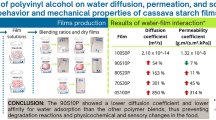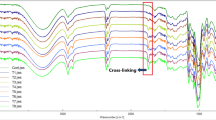Abstract
The effect of temperature and relative humidity on the water vapour permeability (WVP) and mechanical properties of cassava starch and soy protein concentrate (SPC) based edible films containing 20 % glycerol level were studied. Tensile strength and elastic modulus of edible films increased with increase in temperature and decreased with increase in relative humidity, while elongation at break decreased. Water vapour permeability of the films increased (2.6–4.3 g.mm/m2.day.kPa) with increase in temperature and relative humidity. The temperature dependence of water vapour permeation of cassava starch-soy protein concentrate films followed Arrhenius relationship. Activation energy (Ea) of water vapour permeation of cassava starch-soy protein concentrate edible films ranged from 1.9 to 5.3 kJ/mol (R 2 ≥ 0.93) and increased with increase in SPC addition. The Ea values were lower for the bio-films than for polyvinylidene chloride, polypropylene and polyethylene which are an indication of low water vapour permeability of the developed biofilms compared to those synthetic films.

Similar content being viewed by others
References
Akbari Z, Ghomashchi T, Moghadam S (2007) Improvement in food packaging industry with biobased nanocomposites. Int J Food Eng 3(4):3
Arvanitoyannis I, Biliaderis CG (1998) Physical properties of polyol-plasticized edible films made from sodium caseinate and soluble starch blends. Food Chem 62(3):333–342
Arvanitoyannis I, Psomiadou E, Yamamoto N (1997) Edible films made from sodiumcaseinate, starches, sugars or glycerol, part 1. Carb Polym 31:179–192
Ariahu CC, Kaze SA, Achem CD (2006) Moisture sorption characteristics of tropical fresh water crayfish. J Food Eng 75:355–363
Ashley RJ (1985) Permeability and plastic packaging. In: Comyn J (ed) Polymer permeability. Elsevier Applied Science Publishers, London, pp 269–308
Bertuzzi MA, Armada M, Gottifredi JC (2007) Physicochemical characterization of starch based films. J Food Eng 82:17–25
Bourtoom T, Chinnan MS (2008) Preparation and properties of rice starch-chitosan blend biodegradable film. LWT - Food Sci Tech 41:1633–1641
Chinma CE, Ariahu CC, Abu JO (2012) Development and characterization of edible films based on cassava starch and soy protein concentrate blends. Int J Food Sci Techn 47(2):383–389
Chinma CE, Ariahu CC, Alakali JS (2013) Moisture sorption and thermodynamic properties of cassava starch and soy protein-based edible films. Int J Food Sci Tech 48(11):2400–2407
Cho SY, Rhee C (2002) Sorption characteristics of soy protein films and their relation to mechanical properties. Lebensm Wiss Technol 35:151–157
Hong S, Krotcha JM (2006) Oxygen barrier performance of whey-protein coated plastic films as affected by temperature, relative humidity, base film and protein type. J Food Eng 73(3):484–493
Ihekoronye AL, Ngoddy PO (1985) Integrated food science and technology for the tropics. Macmillian publishers, London, pp 252–253
Kaya S, Maskan A (2003) Water vapor permeability of pestil (a fruit leather) made from boiled grape juice with starch. J Food Eng 57:295–299
Kokoszka S, Debeaufort F, Hambleton A, Lenart A, Voilley A (2010) Protein and glycerol contents affect physico-chemical properties of soy protein isolate-based edible films. Innovative Food Sci Emerg Techn. doi:10.1016/j.ifset.2010.01.006
Labuza TP (1984). Determination of moisture sorption isotherms. In: Moisture Sorption: Practical Aspects of Isotherm Measurement and Use. St. Paul, MN: American Association of Cereal Chemists, pp. 64–73.
Mali S, Grossmann M, García M, Martino M, Zaritzky N (2008) Antiplasticizing effect of glycerol and sorbitol on the properties of cassava starch films. Braz J Food Tech 11:194–200
Mali S, Grossmann M, García M, Martino M, Zaritzky N (2005) Mechanical and thermal properties of yam starch films. Food Hydrclds 19:157–164
Nasri N, El Tinay NA (2007) Functional properties of fenugreek protein concentrate. Food Chem 103:582–589
Osés J, Fabregat-Vázquez M, Pedroza-Islas R, Tomás SA, Cruz-Orea A, Maté JI (2009) Development and characterization of composite edible films based on whey protein isolate and mesquite gum. J Food Eng 92:56–62
Parra DF, Tadini CC, Ponce P, Lugằo AB (2004) Mechanical properties and water vapor transmission in some blends of cassava starch edible films. Carb poly 58:475–481
Phan The D, Debeaufort F, Voilley A, Luu D (2009) Biopolymer interactions affect the functional properties of edible films based on agar, cassava starch and arabinoxylan blends. J Food Eng 90:548–558
Regalado C, Perez-Perez C, Lara-Cortes E, Garcia-Almendarez B (2006) Whey protein based edible food packaging films and coatings. Advances in Agricultural and Food Biotechnology Editors: Ramón Gerardo Guevara-González and Irineo Torres-Pacheco. Pp 237–261
Rhim JW, Wu Y, Weller CL (2000) Physical characteristics of a composite film of soy protein isolate and propylene glycol alginate. J Food Sci 64:149–152
Rogers CE, Fels M, Li NN (1982) Separation by permeation through polymeric membranes. In: Li NN (ed) Recent developments in separation science. CRC Press, Florida, pp 107–152
Ruegg M (1980) Calculation of the activity of water in sulfuric acids solution at various temperatures. Lebensmittel-wiss and Tech 13:22–24
Steel RDG, Torrie JH (1980) Principles and procedures of statistics. A Biometrical approach. 2nd edn. McGraw Hill Co. New York p 623
Van Soest JJG, Hulleman SHD, de Wit D, Vliegenthart JFG (1996) Crystallinity in starch bioplastics. Ind Crps Prdts 5(1):11–22
Were L, Hettiarachchy NS, Coleman MC (1999) Properties of cysteine-added soy protein-wheat gluten films. J Food Sci 64:514–518
Acknowledgments
The corresponding author is grateful to Federal University of Technology, Minna, Nigeria for the award of postgraduate fellowship.
Author information
Authors and Affiliations
Corresponding author
Rights and permissions
About this article
Cite this article
Chinma, C.E., Ariahu, C.C. & Alakali, J.S. Effect of temperature and relative humidity on the water vapour permeability and mechanical properties of cassava starch and soy protein concentrate based edible films. J Food Sci Technol 52, 2380–2386 (2015). https://doi.org/10.1007/s13197-013-1227-0
Revised:
Accepted:
Published:
Issue Date:
DOI: https://doi.org/10.1007/s13197-013-1227-0




